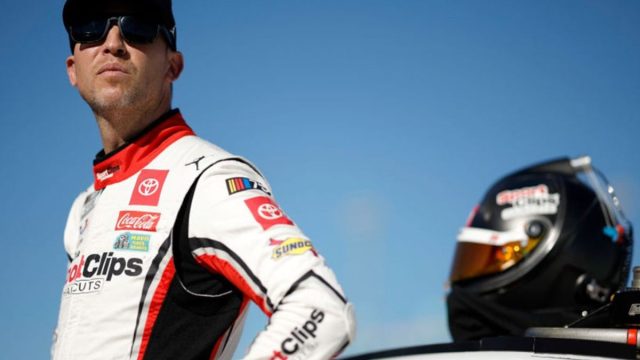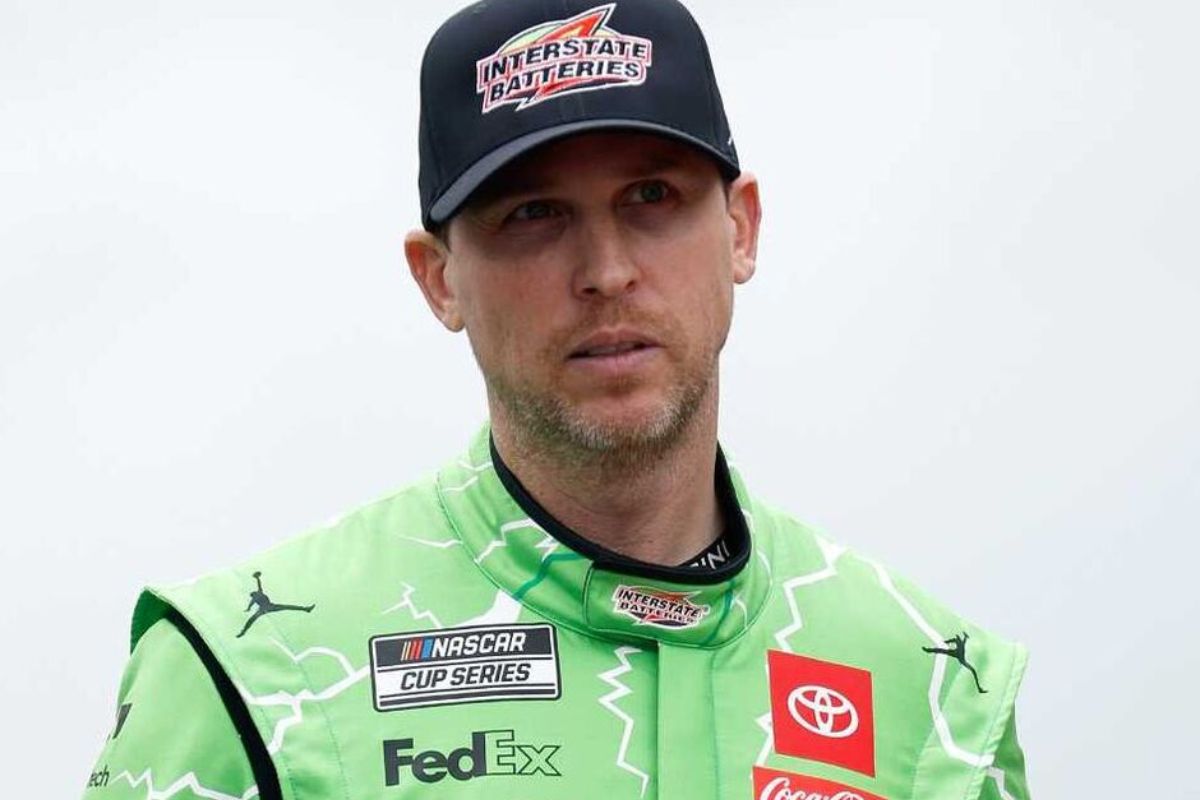Denny Hamlin Urges NASCAR: In NASCAR, Denny Hamlin‘s recent call for the reintroduction of Chicagoland Speedway marks a significant pivot towards revitalizing traditional racing venues that resonate with both drivers and fans. His advocacy highlights the potential of the track to complement the capabilities of the Next Gen car, promising improved competitive races and possibly altering the current trajectory of the sport’s venue strategy. By focusing on how Chicagoland’s unique features could lift the overall NASCAR experience, Hamlin’s proposal invites a broader discussion on balancing innovation with tradition in the scheduling of race locations.
Key Takeaways
- Denny Hamlin advocates for the reintroduction of Chicagoland Speedway to NASCAR’s race calendar.
- Chicagoland’s suitability for the Next Gen car enhances race quality and competitiveness.
- Reintroducing Chicagoland could diversify NASCAR’s marketability and attract a broader audience.
- Hamlin emphasizes balancing innovation with tradition by reviving historic tracks.
- The return of Chicagoland could optimize Next Gen car performances, appealing to both racers and fans.
Exciting Racing at Kansas Speedway
The AdventHealth 400 race at Kansas Speedway recently revitalized fan enthusiasm with its highly competitive and engaging display, marking a significant improvement from previous criticisms of the Next Gen car’s performance. This event, occurring on the mile-and-a-half track, demonstrated the Next Gen car’s capability to support intense, side-by-side racing, which has been a rare sight in recent times.
The Next Gen car, introduced with an aerodynamically heavy design, had initially faced backlash for promoting processional races that lacked overtaking opportunities. However, the Kansas Speedway race turned these perceptions around. The duel between Ross Chastain and Kyle Larson, particularly in the early stages of the race, presented the car’s improved racing dynamics.
Moreover, the positive reception from the audience, quantified by a 95.8% approval rating in Jeff Gluck’s well-regarded race poll, set a new benchmark for the series. This overwhelming approval emphasizes a significant shift in fan perception, directly attributable to the observable enhancements in race quality and competitiveness.
Analyzing the technical aspects, the Kansas race indicated that adjustments to the Next Gen car’s setup could be key in maximizing its full potential. The ability to maintain close quarter racing without significant loss of speed or control suggests that further refinements in car setups and track-specific adjustments could sustain, if not raise, this level of excitement in future races.
Denny Hamlin’s Call for Historic Venues
Denny Hamlin, a seasoned NASCAR driver, has recently advocated for the reintroduction of historic venues such as Chicagoland and Kentucky Speedway into the racing schedule. Hamlin’s stance is rooted in a broader conversation about the evolution of NASCAR’s competitive environments and their alignment with contemporary racing technologies. His call is not merely nostalgic; it’s an informed proposal targeting the strategic improvement of the race calendar to optimize the performance of the Next Gen car.
Hamlin’s argument pivots on the characteristics of the mile-and-a-half tracks, which he believes are ideally suited to the dynamics of the Next Gen car. These tracks, exemplified by Chicagoland and Kentucky Speedway, offer a unique blend of challenges that test a driver’s skill and the car’s capabilities, potentially leading to more competitive and engaging races. The design and asphalt composition of these tracks allow for high-speed racing while also demanding aerodynamic efficiency and tire management.
Furthermore, Hamlin’s perspective is that reintroducing these tracks could enrich NASCAR’s marketability by diversifying the types of venues that are featured. This diversification can attract larger audiences and increase engagement from a fan base thirsty for variety and historical resonance in the racing calendar.
Chicagoland and Kentucky Speedway’s Potential Return
Considering the advancements in NASCAR’s Next Gen car, the potential return of Chicagoland and Kentucky Speedway could greatly improve the competitive landscape of the series. These tracks, which were sidelined partly due to declining attendance and the impacts of the COVID-19 pandemic, have unique characteristics that are well-suited to the dynamics of the Next Gen car. Denny Hamlin, a seasoned NASCAR driver, has publicly supported the idea, emphasizing that the Next Gen car’s performance on mile-and-a-half tracks like Chicagoland highlights thrilling, competitive racing.
“We should be going back to Chicagoland for sure.”
“Let’s start with Roval. Let’s start there. This car is made for mile-and-a-half tracks, we’re running through the parking lot at Charlotte Motor Speedway… Chicagoland I can’t speak to the facilities. I think it’s probably comparable to Kansas. Doesn’t have a bunch of suites but it’s decent enough and clean enough to warrant going back there. Not really sure why we stopped going there.” – hamlin
Chicagoland Speedway, in particular, has been praised by Hamlin for its racing quality. Without the clutter of excessive suites, its focus remains on the purity of the race itself, presenting an ideal scenario for drivers and fans both. The sentiment suggests a push towards returning to venues that prioritize racing quality over commercial frills, aligning with the Next Gen car’s capabilities.
Kentucky Speedway, while not specifically highlighted by Hamlin, also fits into the category of mile-and-a-half tracks that could benefit from the advanced features of the Next Gen car. The aerodynamics and improved handling could lead to more dynamic races, potentially rejuvenating interest and attendance.
The strategic reintroduction of these tracks could not only revive interest among seasoned fans but also attract a new demographic, capitalizing on the advanced racing experience provided by the Next Gen cars.
Denny Hamlin’s Disappointment at Kansas
While Denny Hamlin has been a vocal advocate for the return of certain NASCAR tracks, his recent performance at Kansas Speedway highlighted the challenges even seasoned drivers face in optimizing track position and strategy. At Kansas, a track known for its speed dynamics and strategic complexities, Hamlin found himself grappling with key decisions that would ultimately define his race outcome.
Hamlin’s preference for mile-and-a-half tracks like Kansas is well-documented, yet during this event, his proficiency was tested. Despite starting from a promising position, Hamlin’s choice during an important restart became a focal point of scrutiny. Opting for the inside lane, he faced immediate challenges from Kyle Larson, a sharp competitor who seized an aggressive line behind him. This move by Larson was not just about overtaking; it was a strategic exploitation of the track’s geometry and the aerodynamic interplay at high speeds.
The consequence of Hamlin’s lane selection was a loss of defensive viability against Larson’s advance. Sandwiched between the race winner Larson and #17, Hamlin struggled to maintain his line while also attempting to reclaim or advance his position.
Ultimately, Hamlin’s inability to fend off Larson relegated him to a fifth-place finish. This result, while respectable, was a stark reminder of the relentless strategic demands of NASCAR racing and the continuous adaptation required even from veterans like Hamlin.
Lessons Learned for Denny Hamlin
Reflecting on his strategic choices at Kansas Speedway, Hamlin has pinpointed key lessons that could improve his future performances. This introspective analysis follows a significant race event where Hamlin, despite a strong season, confronted his tactical vulnerabilities. His post-race reflections centered on the decision-making process during important moments, particularly his preference for defending a specific side of the race track — a choice he now reevaluates.
“I feel like it’s easier to defend the right side than it is the left side with all the apron and everything that’s going on. Lesson learned for sure. I mean, you just kinda put this one in the notebook of like remember these decisions. Certainly, there was one Daytona 500 back in 2017 that I had control of green white checkered and chose the wrong lane. Certainly, I chose the wrong lane this time.” – hamlin
Hamlin’s candor about preferring to defend the right side rather than the left reveals a detailed understanding of race dynamics and personal tendencies that could be exploited by competitors. This insight is not merely about a singular race but show a broader strategic adjustments that might be necessary.
News in Brief: Denny Hamlin Urges NASCAR
Denny Hamlin’s advocacy for reintegrating Chicagoland Speedway into NASCAR’s schedule highlights a strategic effort to improve the racing circuit by leveraging both tradition and innovation.
Such a move promises to not only revitalize fan interest but also to capitalize on the capabilities of the Next Gen car, potentially enriching the competitive dynamics and broadening audience appeal.
Hamlin’s initiative thus demonstrates a thoughtful approach to evolving the NASCAR series while honoring its historical venues.
Our Reader’s Queries
Q. How did Denny Hamlin get into NASCAR?
A. In 2005, at the Kansas Speedway, Denny Hamlin embarked on his NASCAR Cup Series debut under the banner of Joe Gibbs Racing (JGR). Reflecting on his journey, Hamlin acknowledged J.D. Gibbs, seen in a 2009 Twitter video, as the architect of his initial opportunity with the esteemed racing team. Hamlin’s sentiments, shared in 2017, shows Gibbs’ pivotal role in kickstarting his career at Joe Gibbs Racing.
Q. Does Denny Hamlin have a private jet?
A. Following Tyler Reddick’s victory for his team 23XI, Denny Hamlin was captured boarding his private jet, as depicted in a YouTube video titled “Denny Hamlin Gets On Jet After 23XI Win.” The scene captures the post-race moment, illustrating Hamlin’s departure after the checkered flag waved for his team.
ALSO READ: Denny Hamlin Blames Richard Childress for Missed Win



